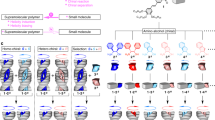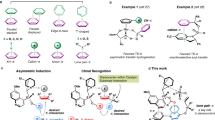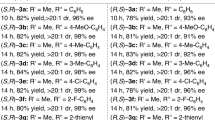Abstract
From receptors in the nose to supramolecular biopolymers, nature shows a remarkable degree of specificity in the recognition of chiral molecules, resulting in the mirror image arrangements of the two forms eliciting quite different biological responses1,2. It is thus critically important that during a chemical synthesis of chiral molecules only one of the two three-dimensional arrangements is created. Although certain classes of chiral molecules (for example secondary alcohols3,4) are now easy to make selectively in the single mirror image form, one class—those containing quaternary stereogenic centres (a carbon atom with four different non-hydrogen substituents)—remains a great challenge5,6,7,8. Here we present a general solution to this problem which takes easily obtainable secondary alcohols in their single mirror image form and in a two-step sequence converts them into tertiary alcohols (quaternary stereogenic centres). The overall process involves removing the hydrogen atom (attached to carbon) of the secondary alcohol and effectively replacing it with an alkyl, alkenyl or aryl group. Furthermore, starting from a single mirror image form of the secondary alcohol, either mirror image form of the tertiary alcohol can be made with high levels of stereocontrol. Thus, a broad range of tertiary alcohols can now be easily made by this method with very high levels of selectivity. We expect that this methodology could find widespread application, as the intermediate tertiary boronic esters can potentially be converted into a range of functional groups with retention of configuration.
This is a preview of subscription content, access via your institution
Access options
Subscribe to this journal
Receive 51 print issues and online access
$199.00 per year
only $3.90 per issue
Buy this article
- Purchase on Springer Link
- Instant access to full article PDF
Prices may be subject to local taxes which are calculated during checkout



Similar content being viewed by others
References
Crossley, R. The relevance of chirality to the study of biological activity. Tetrahedron 48, 8155–8178 (1992)
Thayer, A. M. Centering on chirality. Chem. Eng. News 85, 11–19 (2007)
Pu, L. & Yu, H.-B. Catalytic asymmetric organozinc additions to carbonyl compounds. Chem. Rev. 101, 757–824 (2001)
Noyori, R. & Hashiguchi, S. Asymmetric transfer hydrogenation catalysed by chiral ruthenium complexes. Acc. Chem. Res. 30, 97–102 (1997)
Riant, O. & Hannedouche, J. Asymmetric catalysis for the construction of quaternary carbon centres: nucleophilic addition on ketones and ketimines. Org. Biomol. Chem. 5, 873–888 (2007)
Christoffers, J. & Baro, A. (eds) Quaternary Stereocentres: Challenges and Solutions for Organic Synthesis (Wiley-VCH, 2005)
Corey, E. J. & Guzman-Perez, A. The catalytic enantioselective construction of molecules with quaternary carbon stereocentres. Angew. Chem. Int. Ed. 37, 388–401 (1998)
Shibasaki, M. & Kanai, M. Asymmetric synthesis of tertiary alcohols and α-tertiary amines via Cu-catalysed C–C bond formation to ketones and ketimines. Chem. Rev. 108, 2853–2873 (2008)
Thiemann, W. H.-P. Homochirality of the evolution of biospheres. Jpn Soc. Biol. Sci. Space 12, 73–77 (1998)
Levin, G. B., Miller, J. D., Straat, P. A., Lodder, R. A. & Hoover, R. B. Detecting life and biology-related parameters on Mars. 〈http://mars.spherix.com/IEEE%20Pape-FINAL.pdf〉 (2006)
D’Amato, R. J., Loughnan, M. S., Flynn, E. & Folkman, J. Thalidomide is an inhibitor of angiogenesis. Proc. Natl Acad. Sci. USA 91, 4082–4085 (1994)
Rouhi, M. Top pharmaceuticals: thalidomide. Chem. Eng. News 83, 122–123 (2005)
Kolb, H. C., VanNieuwenhze, M. S. & Sharpless, K. B. Catalytic asymmetric dihydroxylation. Chem. Rev. 94, 2483–2547 (1994)
Chen, C.-A., Wu, K.-H. & Gau, H.-M. Highly enantioselective aryl additions of [AlAr3(thf)] to ketones catalyzed by a titanium(IV) catalyst of (S)-binol. Angew. Chem. Int. Ed. 46, 5373–5376 (2007)
Ramón, D. J. & Yus, M. First enantioselective addition of dialkylzinc to ketones promoted by titanium(iv) derivatives. Tetrahedr. Lett. 39, 1239–1242 (1998)
Betancort, J. M., García, C. & Walsh, P. J. Development of the first practical catalyst for the asymmetric addition of alkyl- and arylzinc reagents to ketones. Synlett 2004, 749–760 (2004)
Hoppe, D., Carstens, A. & Kramer, T. Generation of a configurationally stable chiral benzyllithium derivative, and the capricious stereochemistry of its electrophilic substitution. Angew. Chem. Int. Edn Engl. 29, 1424–1425 (1990)
Carstens, A. & Hoppe, D. Generation of a configurationally stable, enantioenriched α-oxy-α-methylbenzyllithium: stereodivergence of its electrophilic substitution. Tetrahedron 50, 6097–6108 (1994)
Matteson, D. S. & Hurst, G. D. Asymmetric synthesis of tertiary alcohols from α-halo boronic esters. Heteroatom Chem. 1, 65–74 (1990)
Matteson, D. S. α-Halo boronic esters in asymmetric synthesis. Tetrahedron 54, 10555–10607 (1998)
Hoppe, D. & Hense, T. Enantioselective synthesis with lithium/(–)-sparteine carbanion pairs. Angew. Chem. Int. Edn Engl. 36, 2282–2316 (1997)
Stymiest, J. L., Dutheuil, G., Mahmood, A. & Aggarwal, V. K. Lithiated carbamates: chiral carbenoids for iterative homologation of boranes and boronic esters. Angew. Chem. Int. Ed. 46, 7491–7494 (2007)
Fujii, A., Hashiguchi, S., Uematsu, N., Ikariya, T. & Noyori, R. Ruthenium(ii)-catalyzed asymmetric transfer hydrogenation of ketones using a formic acid-triethylamine mixture. J. Am. Chem. Soc. 118, 2521–2522 (1996)
Aggarwal, V. K., Fang, G. Y., Ginesta, X., Howells, D. & Zaja, M. Toward an understanding of the factors responsible for the 1,2-migration of alkyl groups in borate-complexes. Pure Appl. Chem. 78, 215–229 (2006)
Fang, G. Y. et al. Asymmetric sulfur ylide reactions with boranes: scope and limitations, mechanism and understanding. J. Am. Chem. Soc. 129, 14632–14639 (2007)
Derwing, C., Frank, H. & Hoppe, D. Chiral benzyllithium compounds: high configurative stability of (R)- and (S)-1-lithioindan-1-yl N,N-diisopropylcarbamate and unexpected stereochemical course of the substitution reactions. Eur. J. Org. Chem. 1999, 3519–3524 (1999)
Jeon, S.-J., Li, H., García, C., LaRochelle, L. K. & Walsh, P. Catalytic asymmetric addition of alkylzinc and functionalized alkylzinc reagents to ketones. J. Org. Chem. 70, 448–455 (2005)
Jeon, S.-J., Ji, H. & Walsh, P. J. A green chemistry approach to a more efficient asymmetric catalyst: solvent-free and highly concentrated alkyl additions to ketones. J. Am. Chem. Soc. 127, 16416–16425 (2005)
Forrat, V. J., Ramón, D. J. & Yus, M. Chiral tertiary alcohols from a trans-1-arenesulfonyl-amino-2-isoborneolsulfonylaminocyclohexane-catalyzed addition of organozincs to ketones. Tetrahed. Asymm. 16, 3341–3344 (2005)
Krasovskiy, A., Kopp, F. & Knochel, P. Soluble lanthanide salts (LnCl3 · 2 LiCl) for the improved addition of organomagnesium reagents to carbonyl compounds. Angew. Chem. Int. Ed. 45, 497–500 (2006)
Acknowledgements
We thank EPSRC for financial support and Frontier Scientific for their donation of boronic esters. We also thank Merck for unrestricted research support. V.K.A. thanks the Royal Society for a Wolfson Research Merit Award and EPSRC for a Senior Research Fellowship.
Author information
Authors and Affiliations
Corresponding author
Supplementary information
Supplementary Information
This file contains Supplementary Methods and Notes and Supplementary References (PDF 745 kb)
Rights and permissions
About this article
Cite this article
Stymiest, J., Bagutski, V., French, R. et al. Enantiodivergent conversion of chiral secondary alcohols into tertiary alcohols. Nature 456, 778–782 (2008). https://doi.org/10.1038/nature07592
Received:
Accepted:
Issue Date:
DOI: https://doi.org/10.1038/nature07592
This article is cited by
-
Ni-catalysed assembly of axially chiral alkenes from alkynyl tetracoordinate borons via 1,3-metallate shift
Nature Chemistry (2024)
-
Boron-enabled 1,3-metallate shift towards axially chiral alkenes
Nature Chemistry (2024)
-
Transition-metal-free C(sp2)–C(sp3) cross-coupling of α-(pseudo)halo aliphatic ketones with boronic acids via a 1,4-metallate shift
Nature Synthesis (2023)
-
Lithiation–borylation methodology in the total synthesis of natural products
Nature Synthesis (2022)
-
Direct C–H metallation of tetrahydrofuran and application in flow
Nature Synthesis (2022)
Comments
By submitting a comment you agree to abide by our Terms and Community Guidelines. If you find something abusive or that does not comply with our terms or guidelines please flag it as inappropriate.



